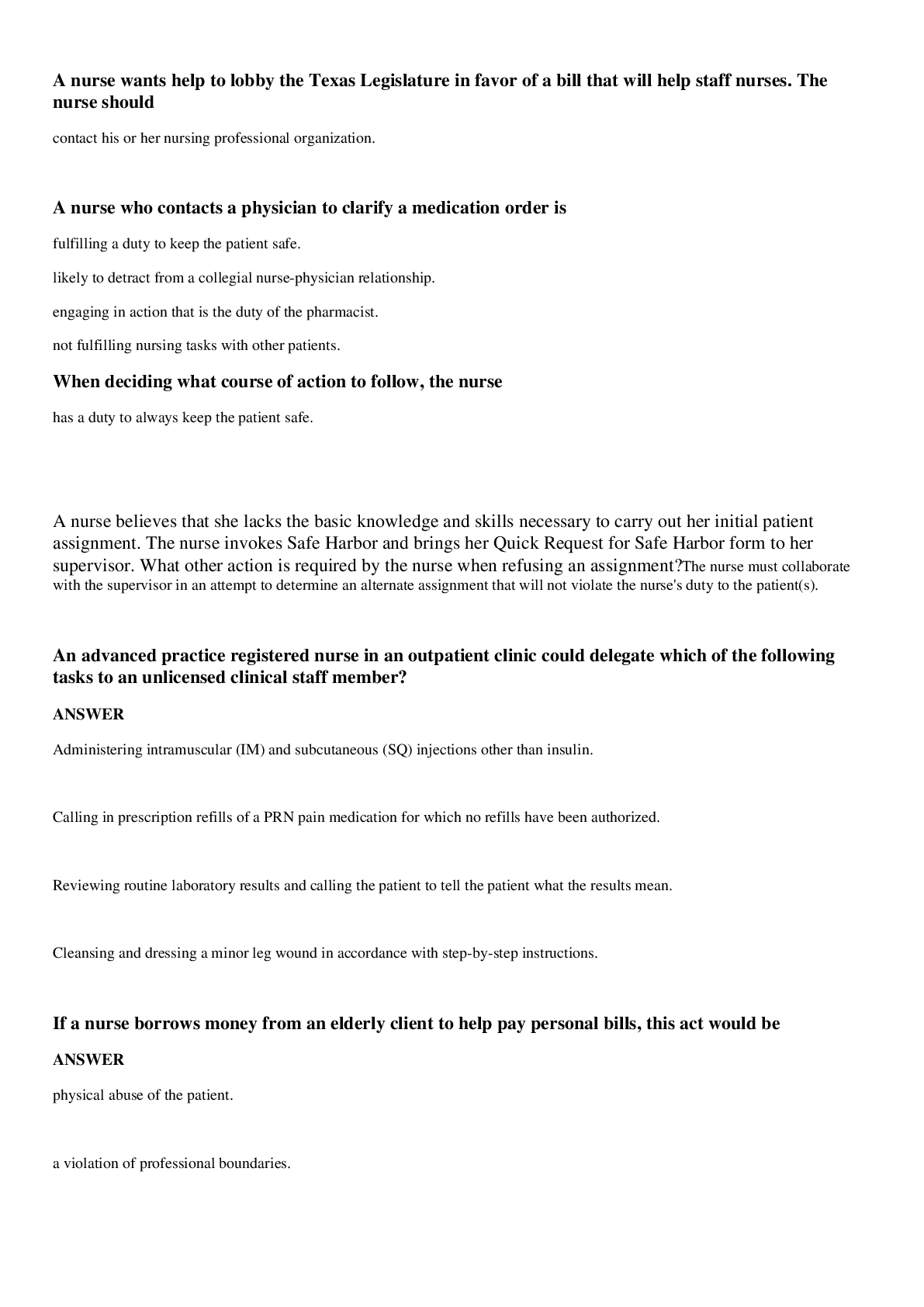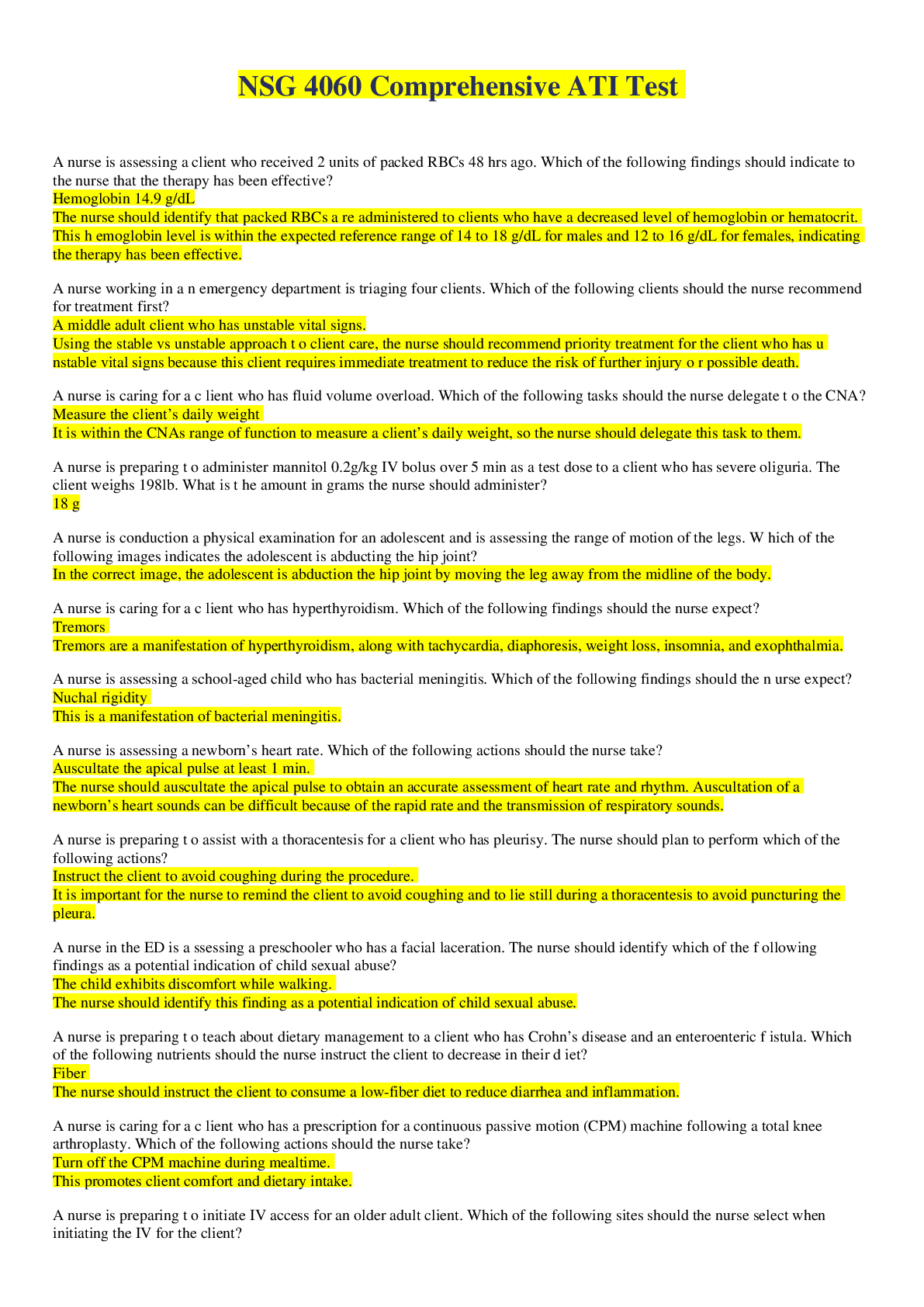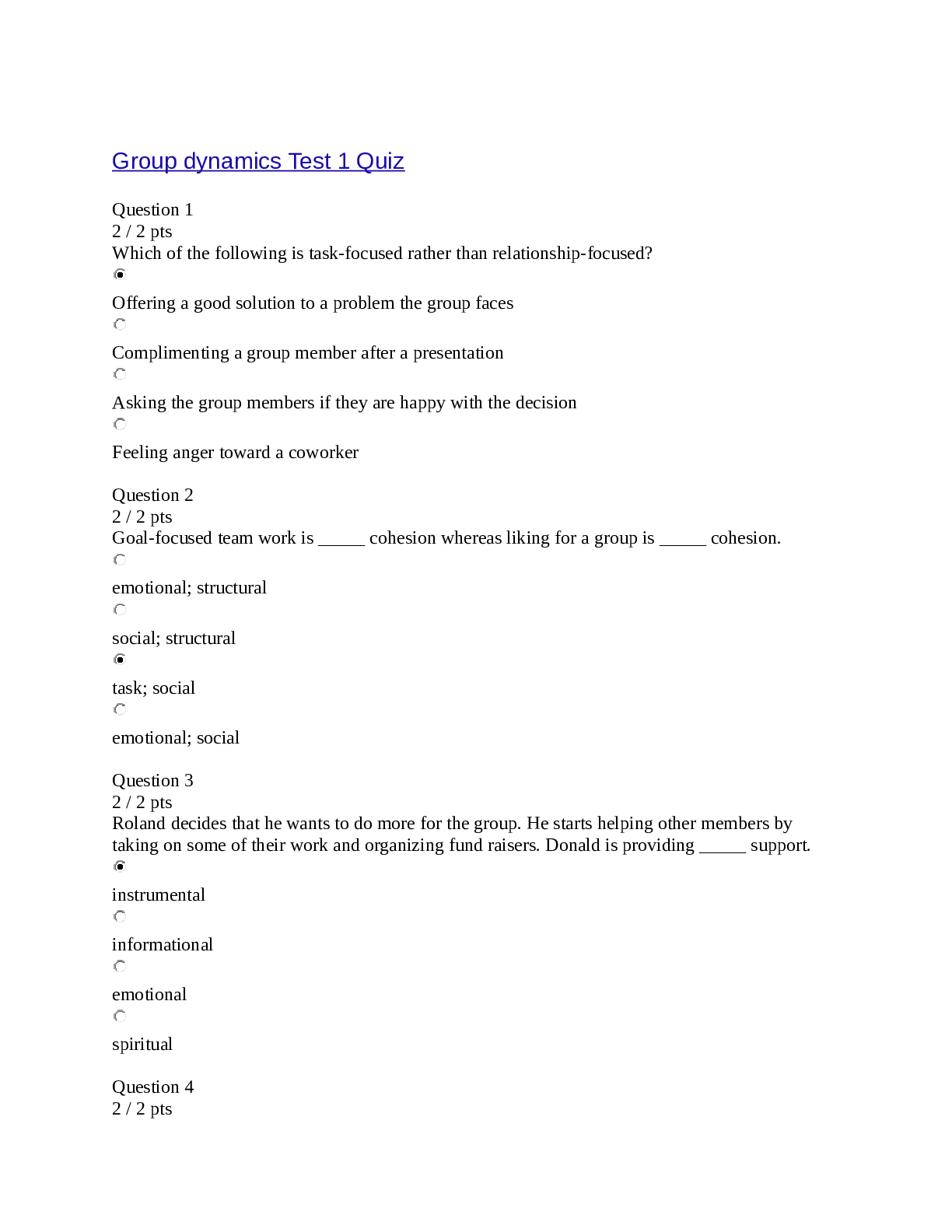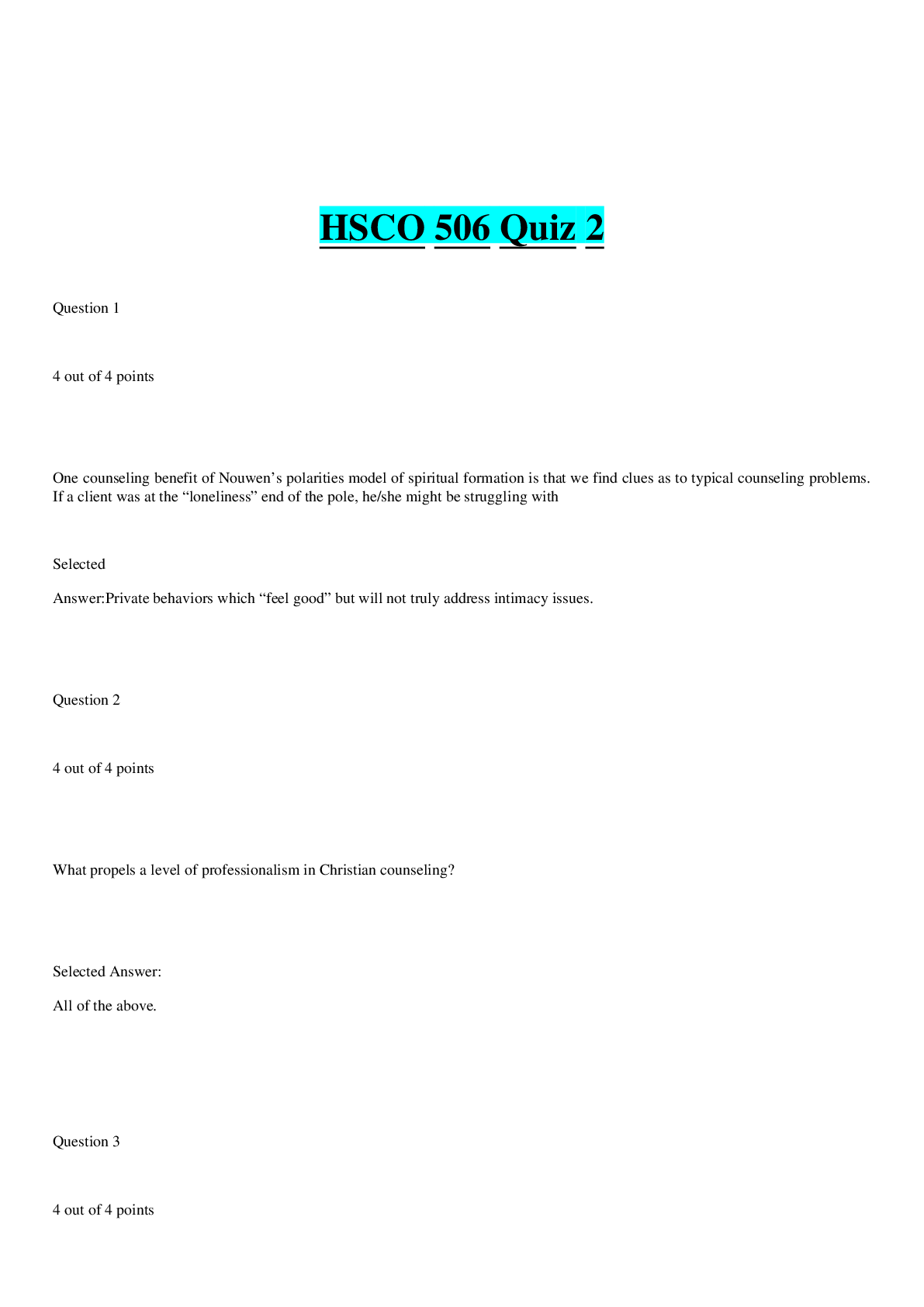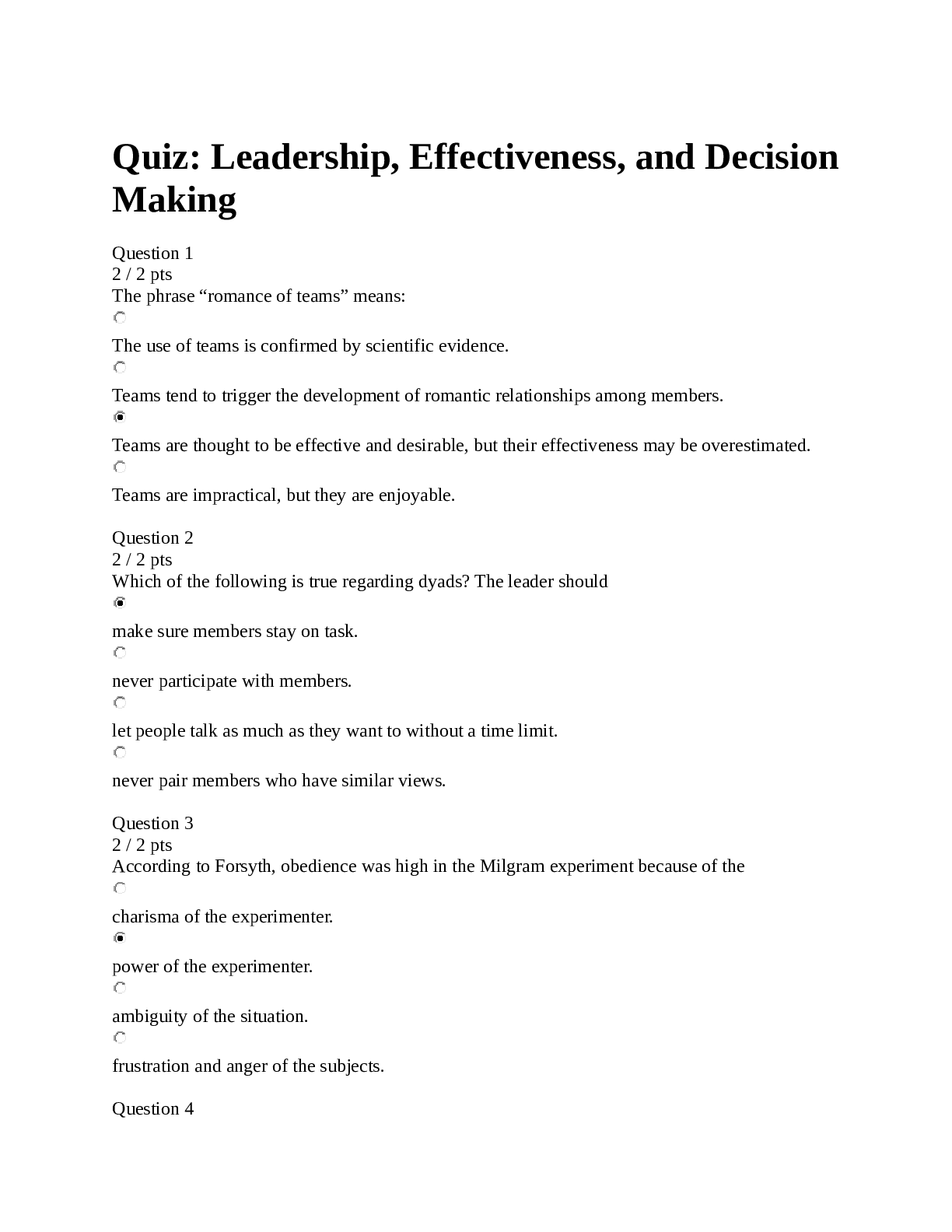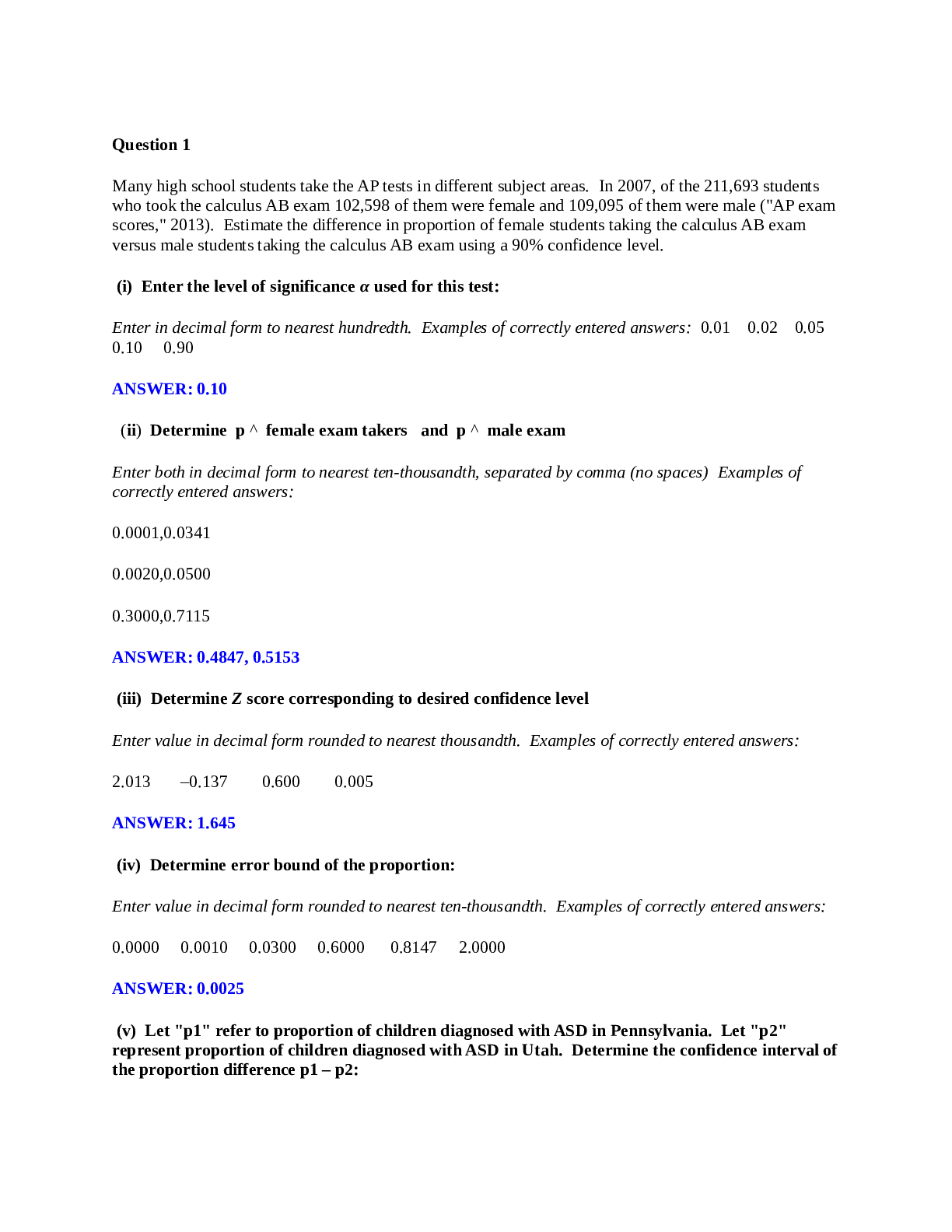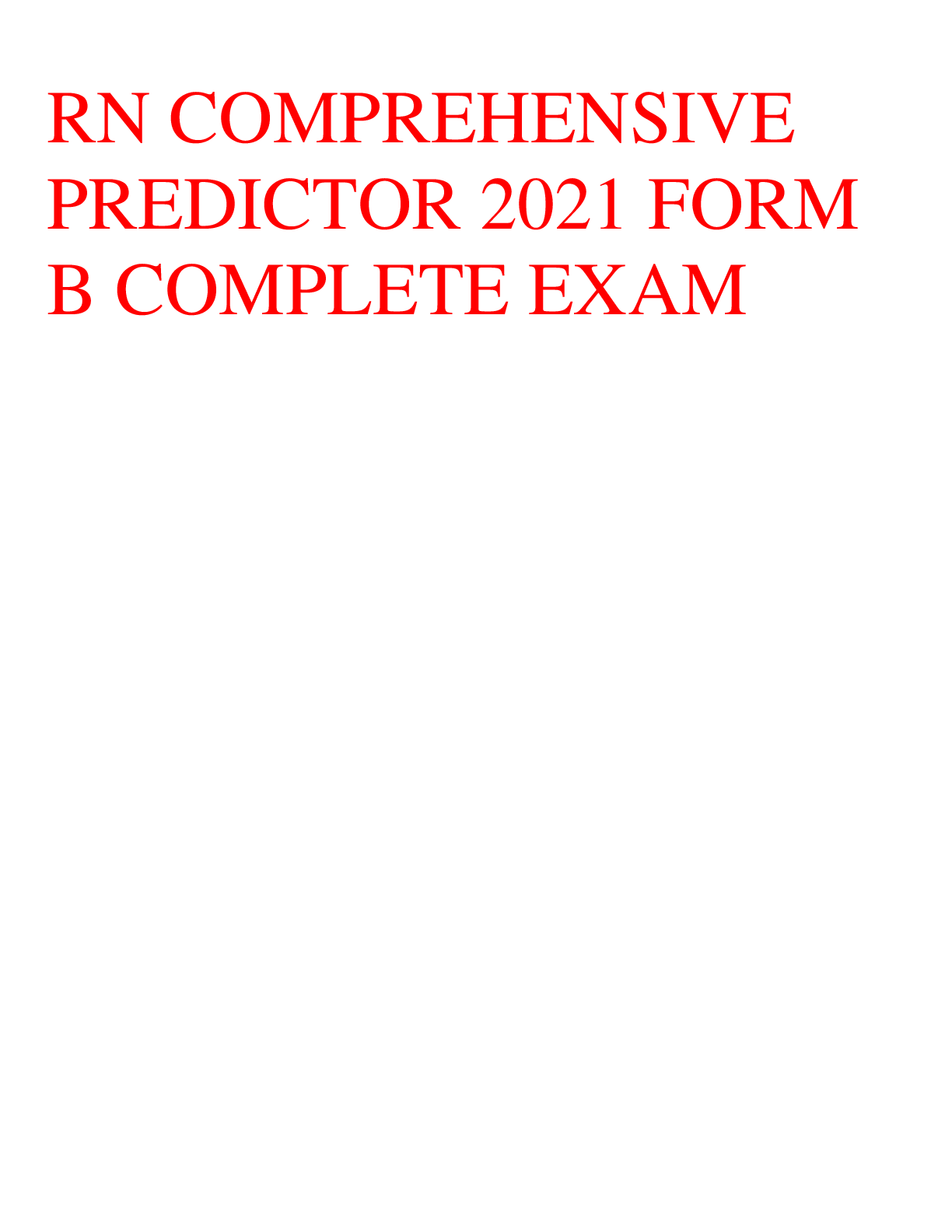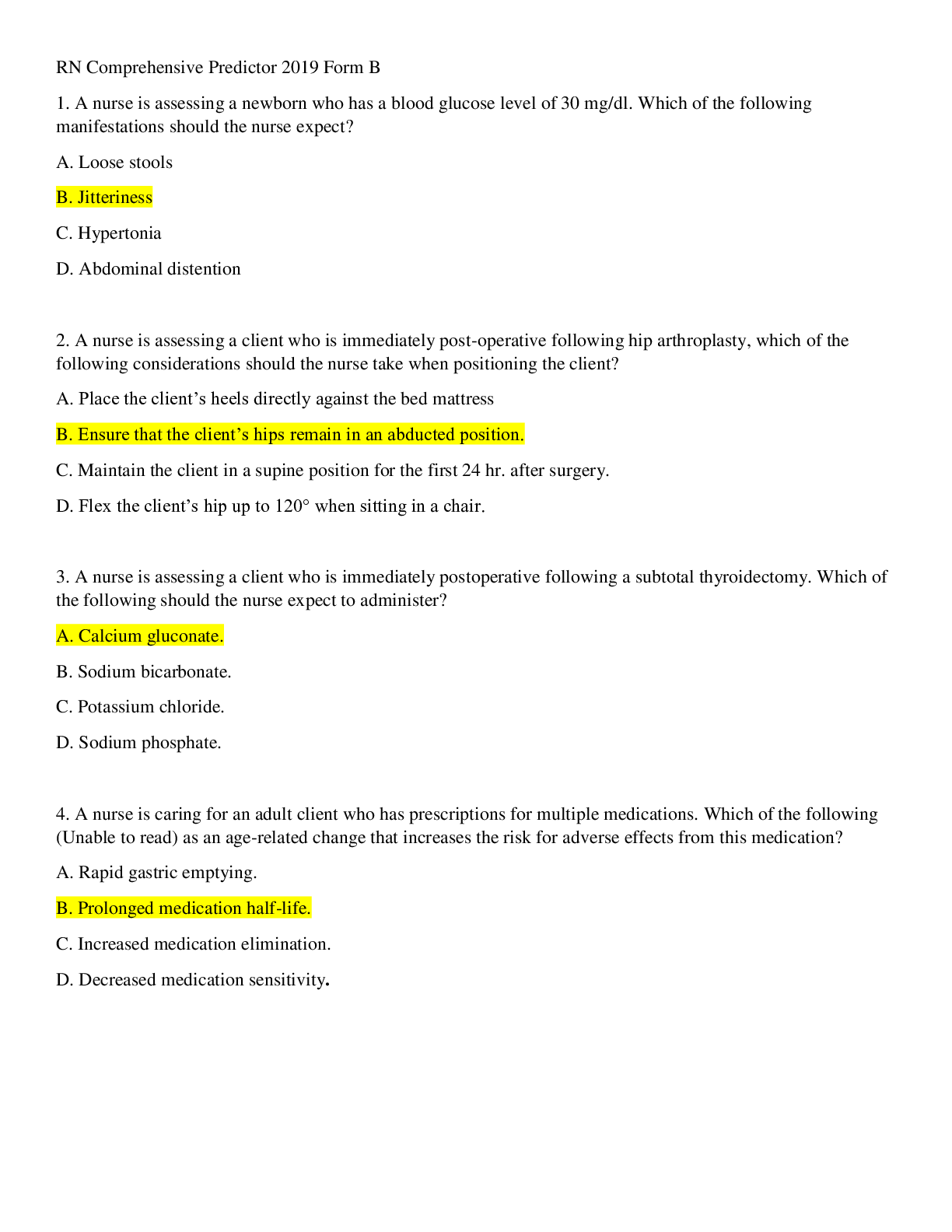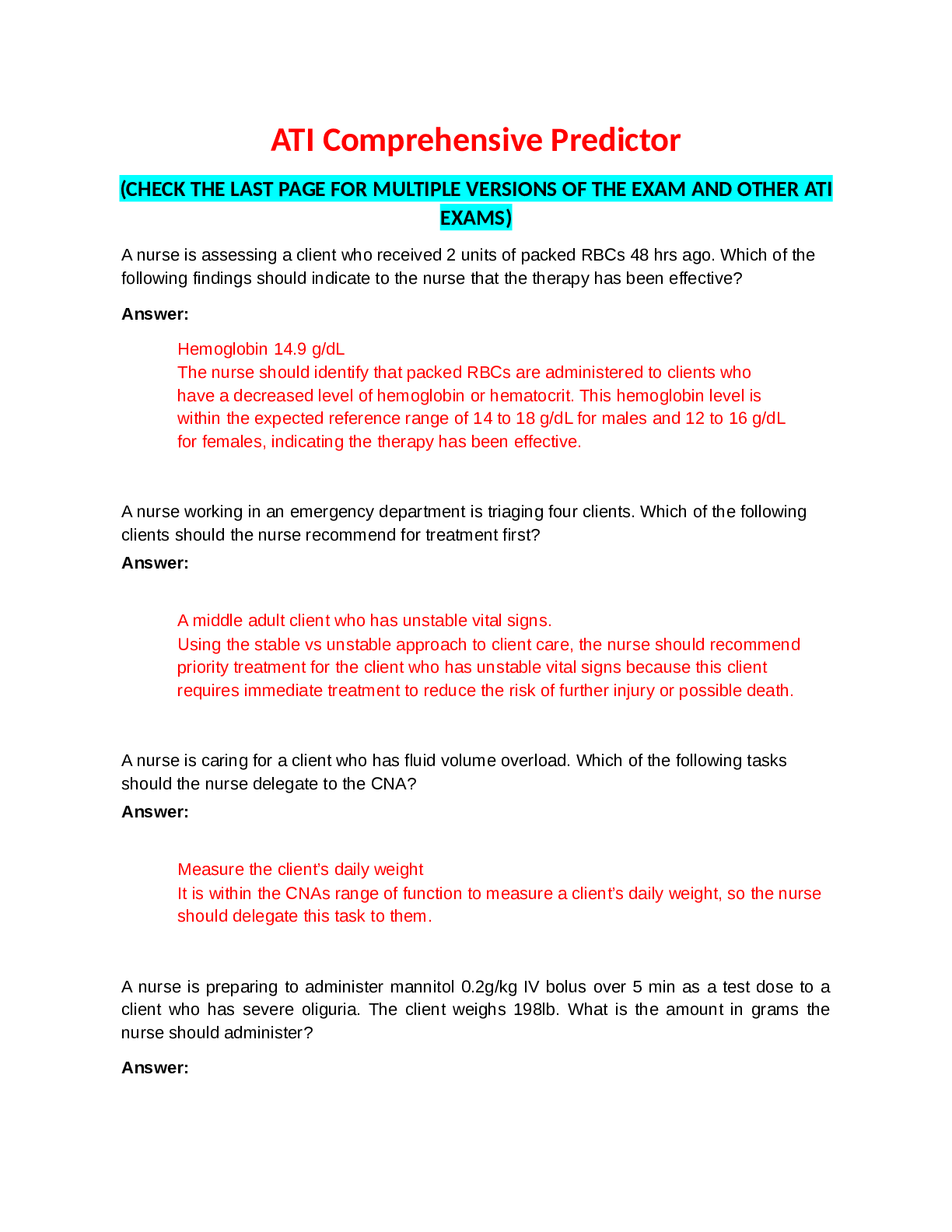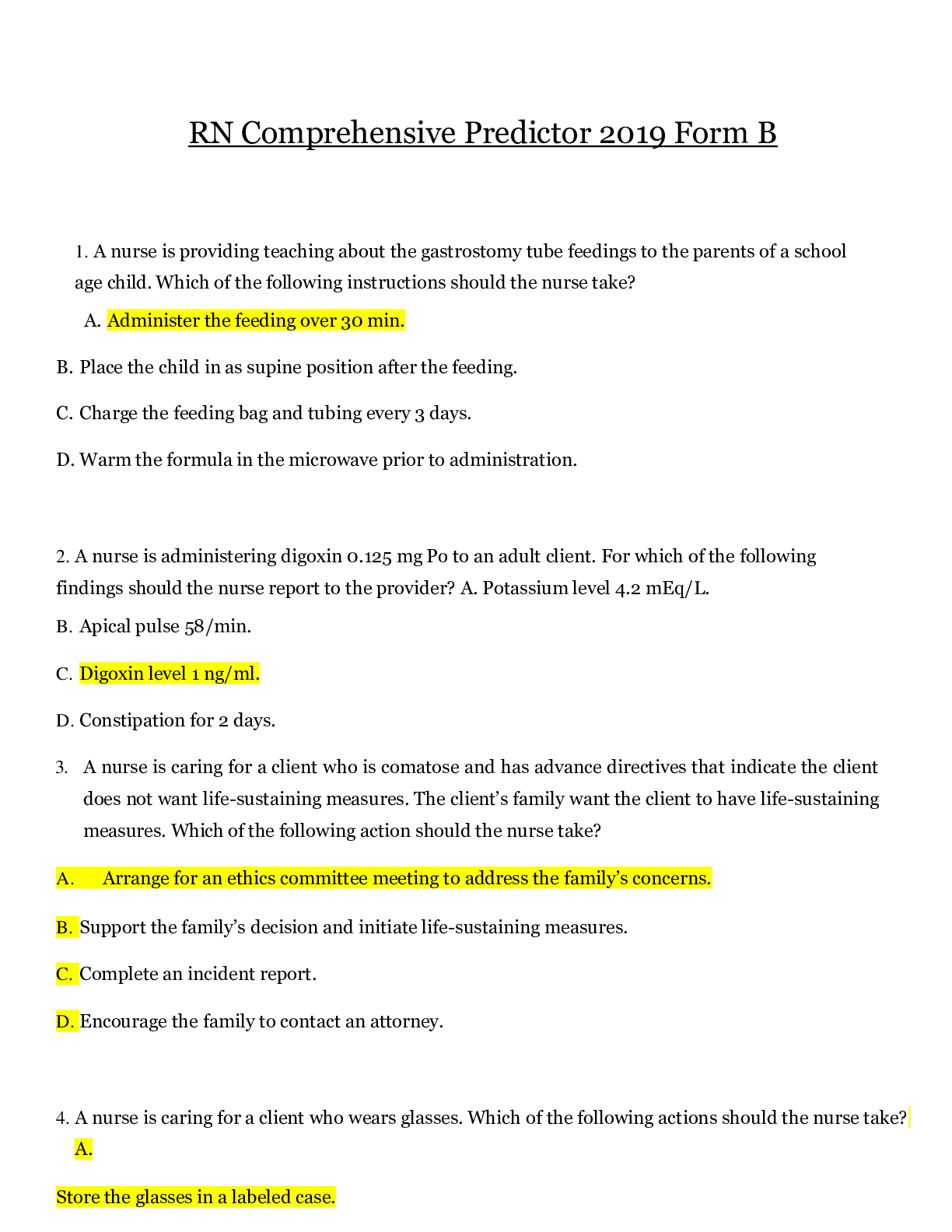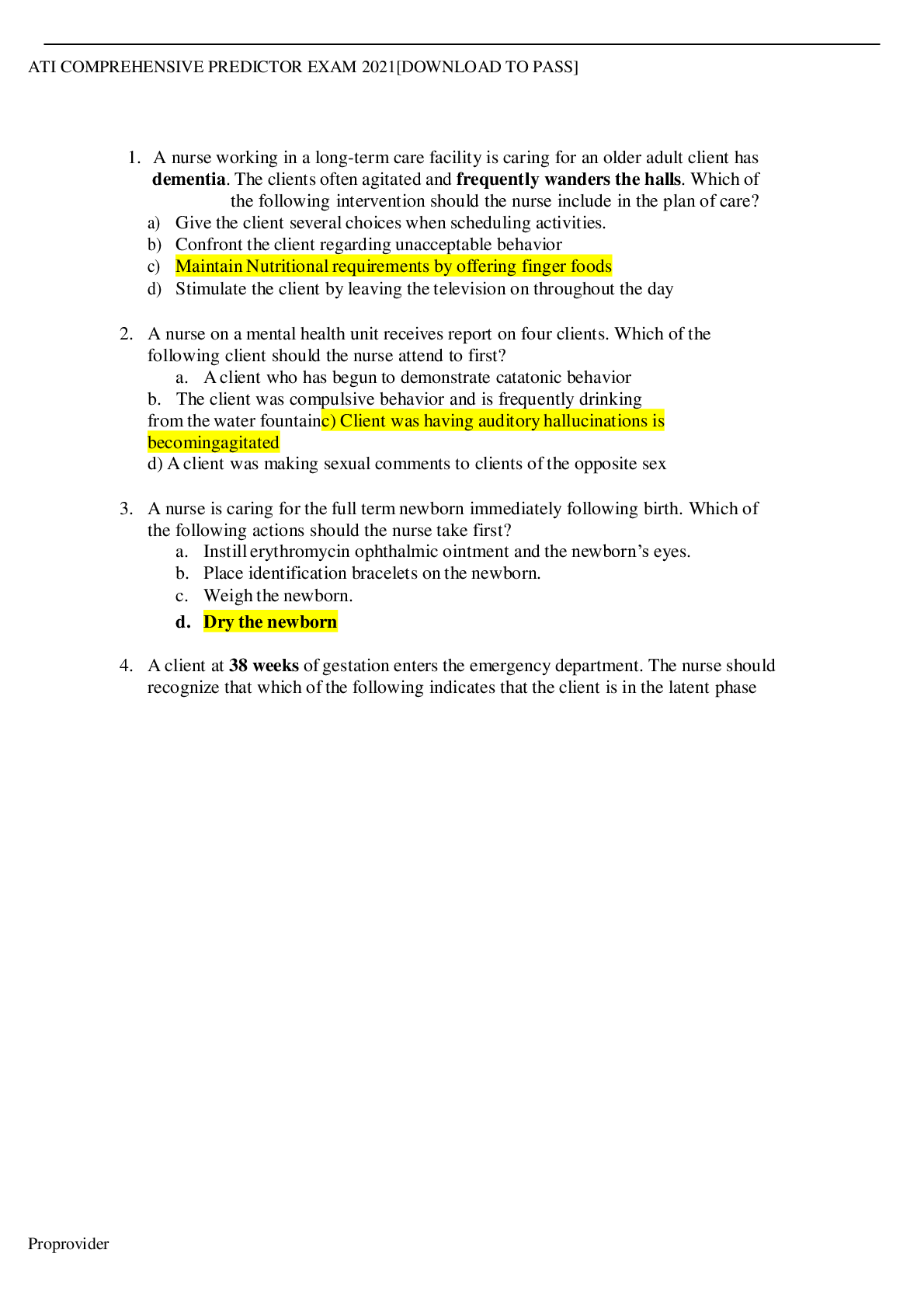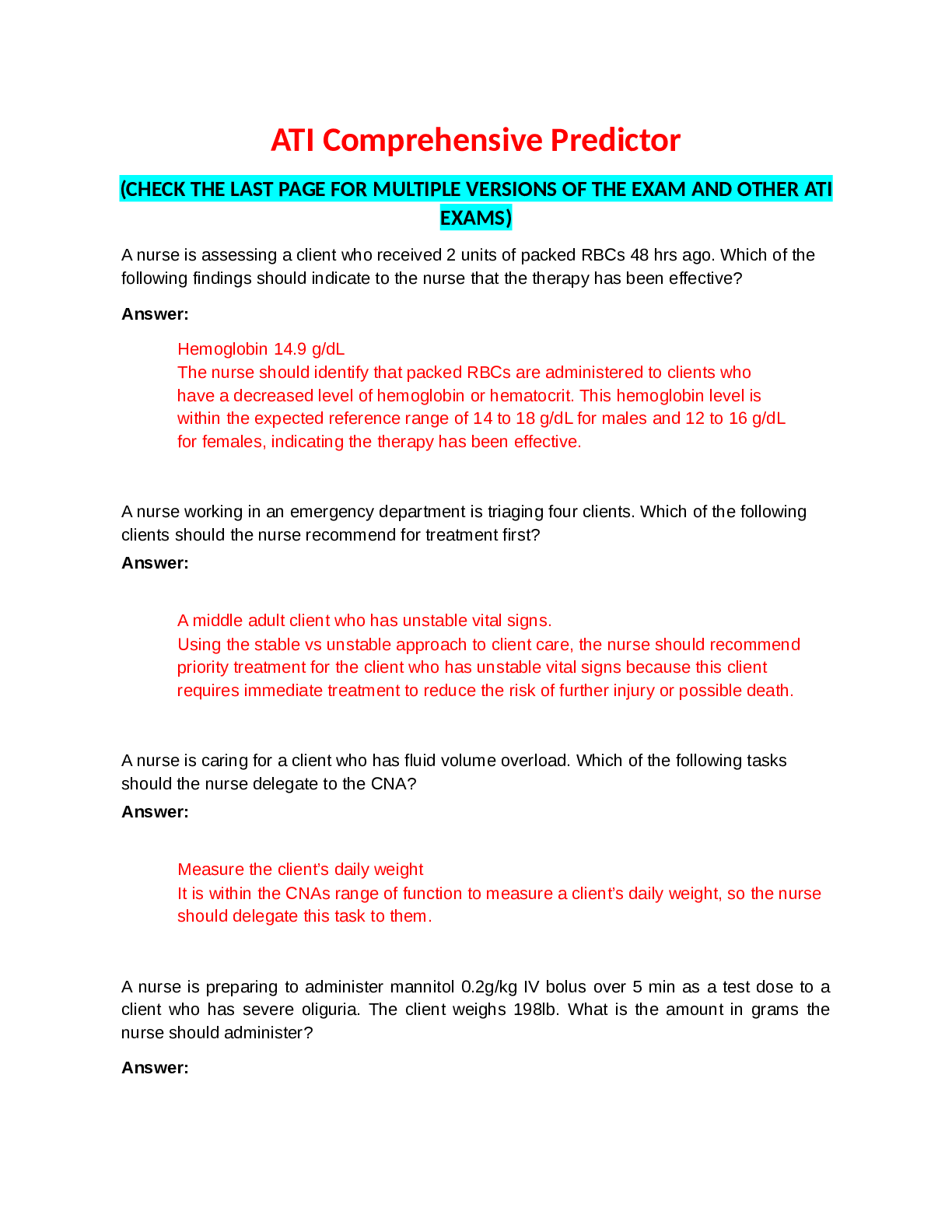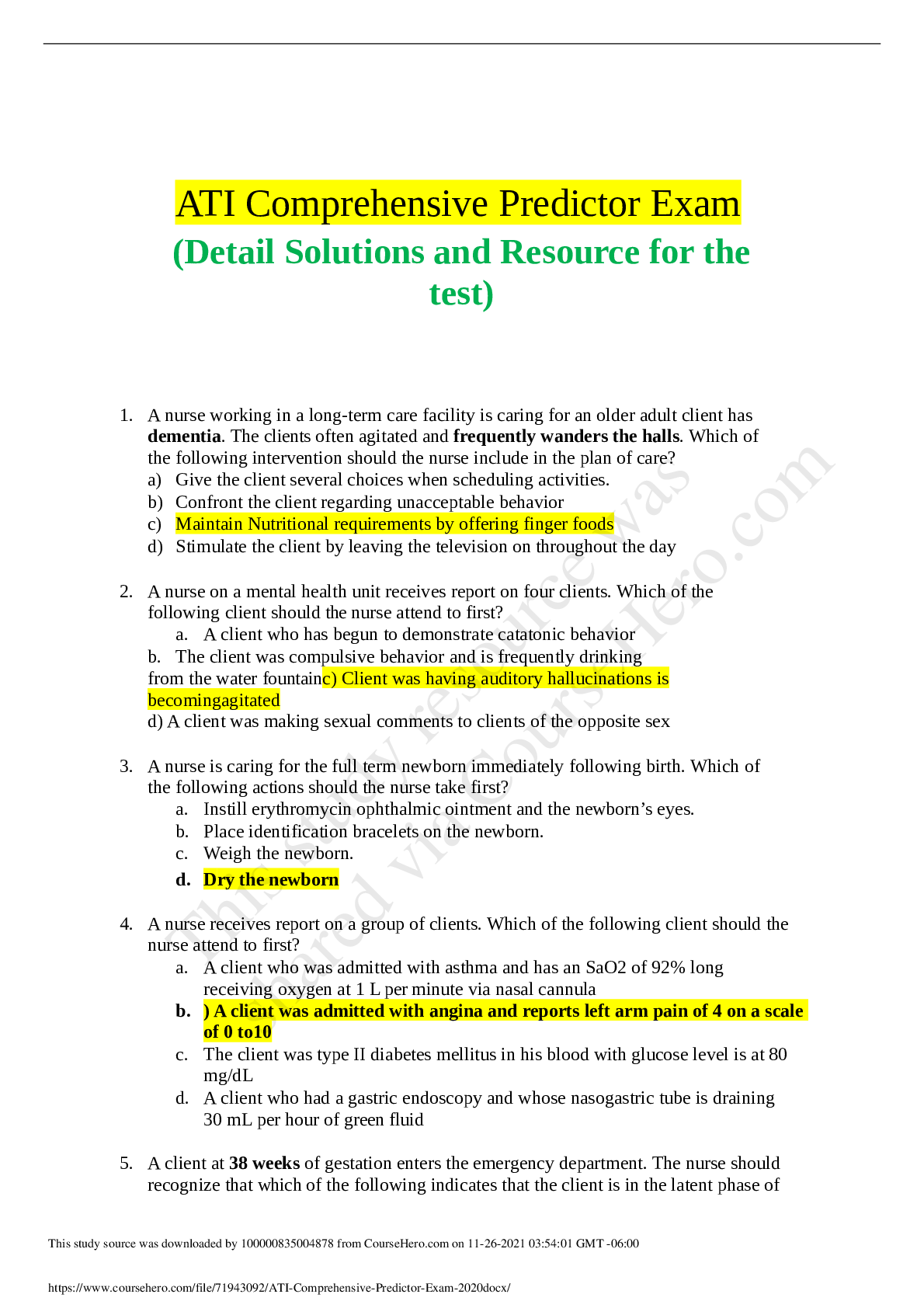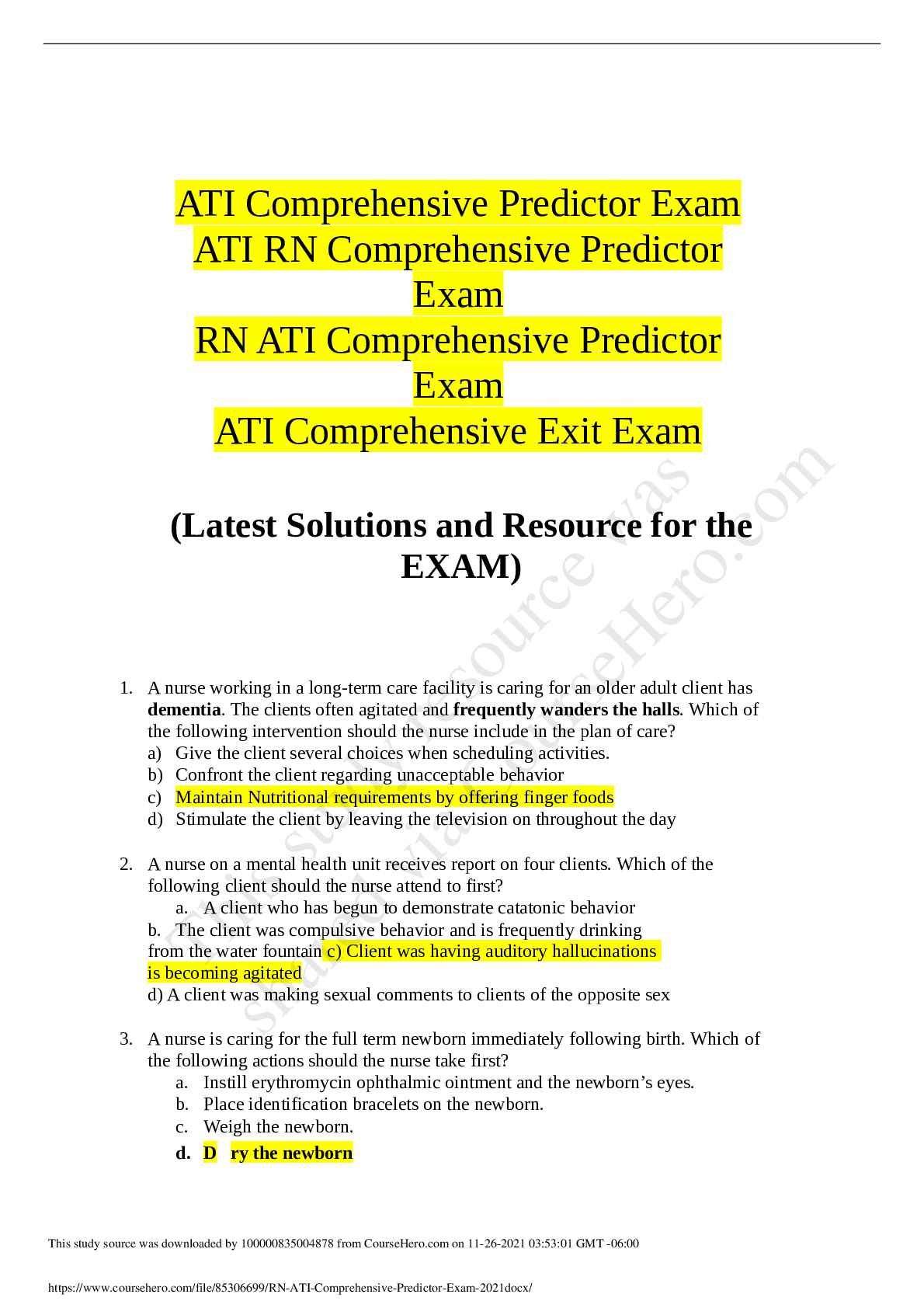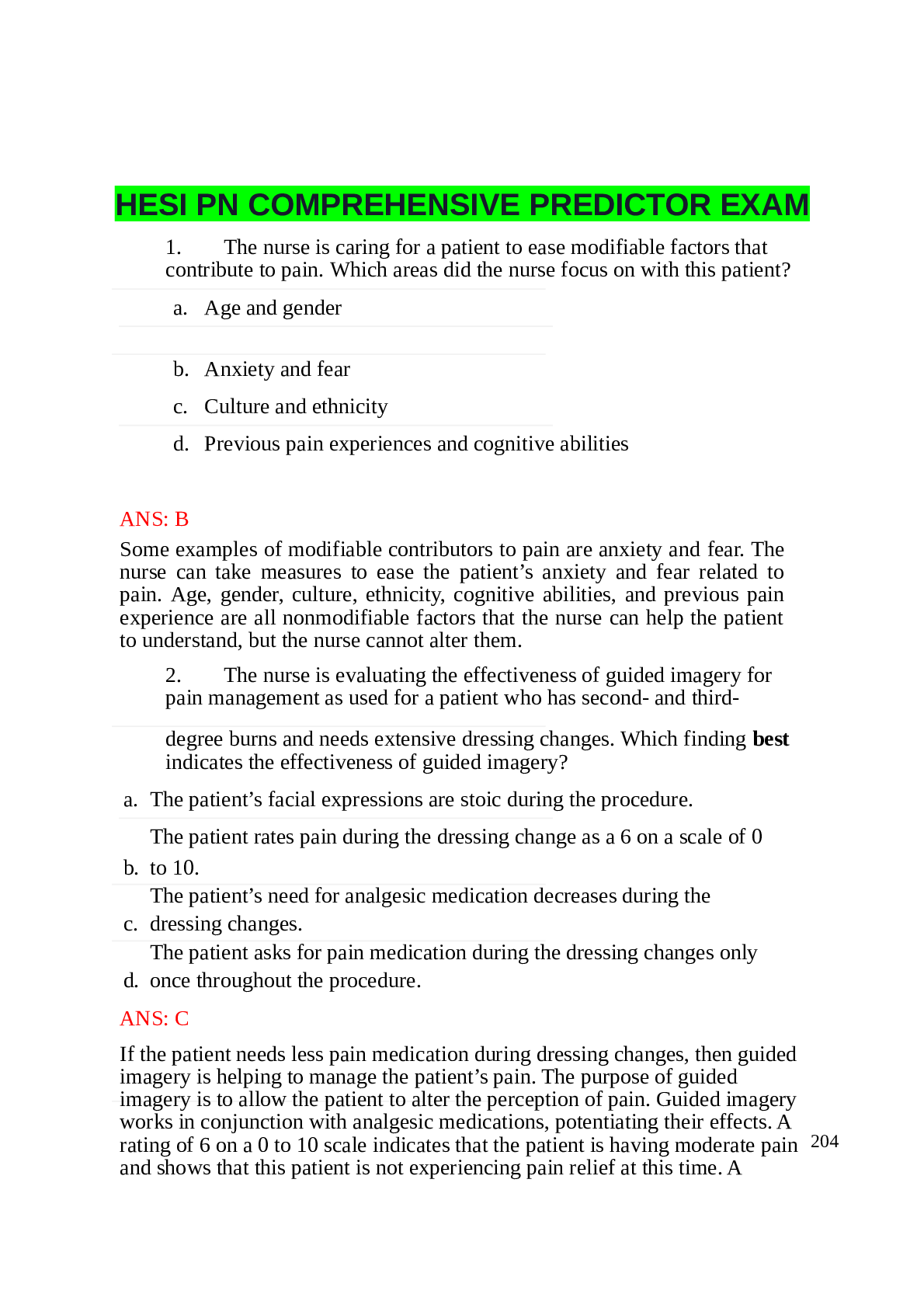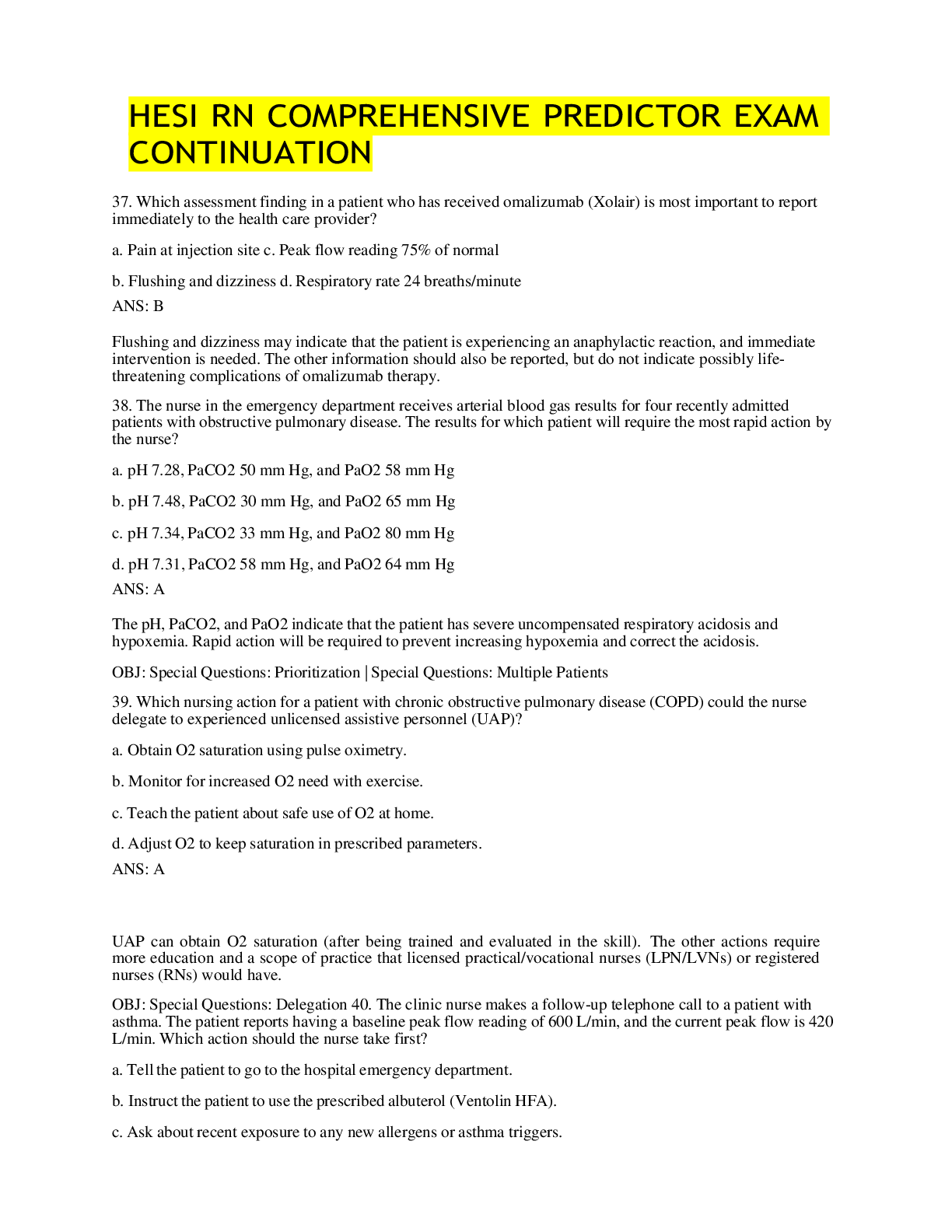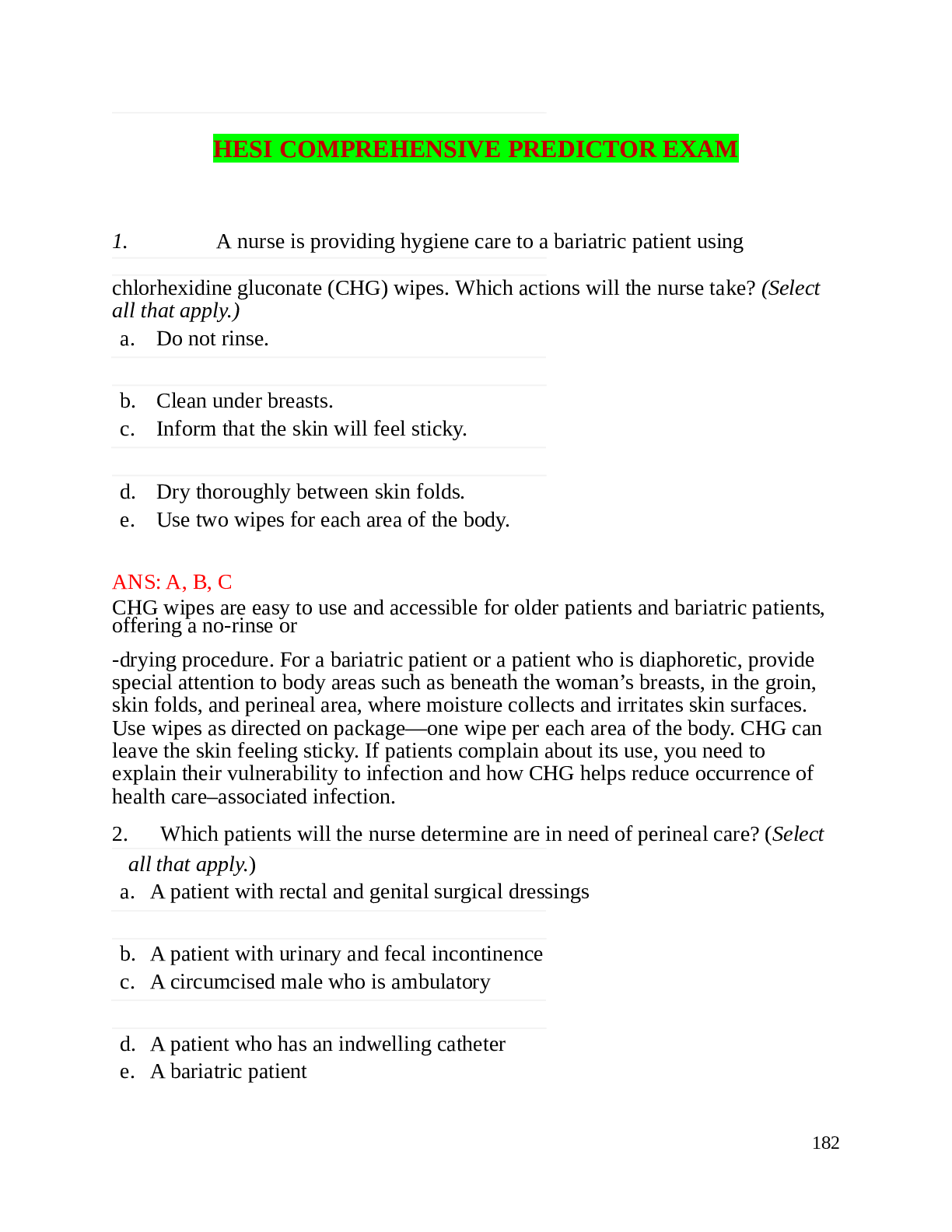*NURSING > QUESTIONS & ANSWERS > ATI RN COMPREHENSIVE PREDICTOR EXAM 2021- LATEST UPDATE (All)
ATI RN COMPREHENSIVE PREDICTOR EXAM 2021- LATEST UPDATE
Document Content and Description Below
1. A nurse is caring for an older adult client who has a new diagnosis of type 2 diabetes mellitus and reports difficulty following the diet and remembering to take the prescribed medication. Which of... the following is NOT an appropriate action by the nurse? A. Ask the dietitian to assist with meal planning. B. Contact the client’s support system. C. Assess for age-related cognitive awareness. D. Encourage the use of a daily medication dispenser. 2. A client had a cardiac catheterization for investigation of angina pain. When teaching about home care after the procedure, the nurse will place importance on a. A liquid diet for the first 24 hours b. Maintaining pressure on the site for 3-4 days c. Having sponge baths only in the first 24 hours d. Reporting any slight discoloration at the site 3. A nurse is evaluating clients at a health fair for modifiable variables affecting health and wellness. The nurse identifies which of the following is the LEAST as a modifiable variable? A. A male who smokes on social occasions B. A female with a BMI of 28 C. An adult with alopecia D. An infant with reflux 4. A nurse is caring for a client who was just told she has breast cancer and the nurse evaluates the client’s response. Which of the following statements by the client reflects a lack of understanding of an illness perspective? A. “I have no family history of breast cancer.” B. “I need a second opinion; there is no lump.” C. “I am glad we live in the city near several large hospitals.” D. “I will schedule surgery next week, over the holidays.” 5. A nurse on a medical-surgical unit is caring for a group of clients. The nurse should identify which of the following clients? A. Client who has an ulceration of the right heel whose blood glucose is 300 mg/dL B. Client who reports right calf pain and shortness of breath C. Client who has blood on a pressure dressing in the femoral area following a cardiac catheterization D. Client who has dark red coloration of left toes and absent pedal pulse 6. A nurse is caring for a client who has ingested a toxic agent. Which of the following actions should the nurse plan to take? i. Induce vomiting. ii. Instill activated charcoal. iii. Perform a gastric lavage with aspiration. iv. Complete a whole-bowel irrigation. A. i, ii, iii B. i, ii, iv C. i, iii, iv D. ii, iii, iv 7. The senior sister claims to use transformation leadership. Which of the following statements BEST describes this type of leadership? a. Uses visioning as the essence of leadership b. Serves her staff rather than being served c. Maintains full trust and confidence in subordinates d. Possesses charisma that makes others feel good in her presence 8. A nurse in the emergency department is assessing a client who is unresponsive. The client’s partner states, “He was pulling weeds in the yard and dropped to the ground.” Which of the following techniques should the nurse use to open the client’s airway? A. Head-tilt, chin-lift B. Modified jaw thrust C. Hyperextension of the head D. Flexion of the head 9. A nurse is reviewing the common emergency management protocol for clients during a cardiac emergency. Which of the following is an appropriate action by the nurse? A. Administer IV dobutamine (Dobutrex). B. Administer IV dopamine (Intropin). C. Administer IV epinephrine (Adrenaline). D. Administer IV atropine (Atropair). 10. A nurse is caring for a client post-lumbar puncture who reports a throbbing headache when sitting upright for meals. Which of the following is NOT an appropriate action by the nurse? A. Use the Glasgow Coma Scale when assessing the client. B. Assist client to eat meals while lying flat in bed. C. Administer an opioid medication. D. Encourage client to increase fluid intake. 11. A nurse is developing a plan of care for a client who is scheduled for a cerebral angiogram with contrast dye. Which of the following statements by the client should the nurse NOT report to the provider? A. “I think I may be pregnant.” B. “I take Coumadin.” C. “I take antihypertensive medication.” D. “I am allergic to shrimp.” 12. A nurse is providing education to a client who is to undergo an electroencephalogram (EEG) the next day. Which of the following information should the nurse include in the teaching? A. “Do not wash your hair the morning of the procedure.” B. “Try to stay awake most of the night prior to the procedure.” C. “The procedure will take approximately 15 minutes.” D. “You will need to lie flat for 4 hours after the procedure.” 13. A nurse is assessing the pain level of a client who has come to the emergency department reporting severe abdominal pain. The nurse asks the client whether he has nausea and has been vomiting. The nurse is assessing which of the following? A. Presence of associated symptoms B. Location of the pain C. Pain quality D. Aggravating and relieving factors 14. A nurse is assessing a client who is reporting pain despite analgesia. The nurse can best assess the intensity of the client’s pain by A. Asking what precipitates the pain. B. Questioning the client about the location of the pain. C. Offering the client a pain scale to measure his pain. D. Using open-ended questions to identify the sensation. 15. A nurse is obtaining a history from a client who has pain. The nurse’s guiding principle throughout this process should be that A. Some clients exaggerate their level of pain. B. Pain must have an identifiable source to justify the use of opioids. C. Objective data are essential in assessing pain. D. Pain is whatever the client says it is. 16. A nurse is caring for a client who is receiving morphine via a patient-controlled analgesia (PCA) infusion device after abdominal surgery. Which of the following statements indicates that the client knows how to use the device? A. “I’ll wait to use the device until it’s absolutely necessary.” B. “I’ll be careful about pushing the button so I don’t get an overdose.” C. “I should tell the nurse if the pain doesn’t stop after I use this device.” D. “I will ask my son to push the dose button when I am sleeping.” 17. A nurse is monitoring a client who is receiving opioid analgesia for adverse effects of the medication. Which of the following effects should the nurse NOT anticipate? A. Diarrhea B. Bradypnea C. Orthostatic hypotension D. Nausea 18. A nurse is assessing a client who reports severe headache and a stiff neck. The nurse’s assessment reveals positive Kernig’s and Brudzinski’s signs. Which of the following actions should the nurse perform first? A. Administer antibiotics B. Implement droplet isolation precautions C. Initiate IV access D. Decrease bright lights 19. A nurse is assessing for the presence of Brudzinski’s sign in a client who has suspected meningitis. Which of the following are NOT appropriate actions by the nurse when performing this technique? A. Place client in supine position. B. Flex client’s hip and knee. C. Place hands behind the client’s neck. D. Bend client’s head toward chest. 20. A nurse is reviewing the health record of a student newly admitted to a university and living in a dormitory. The health record indicates the student requires follow-up immunizations. Which of the following organisms should the nurse plan to vaccinate the student against? A. Streptococcus pneumoniae B. Neisseria meningitidis C. Bartonella henselae D. Rickettsia rickettsii 21. A nurse is planning care for a client who has meningitis and is at risk for increased intracranial pressure (ICP). Which of the following is an appropriate nursing action? A. Implement seizure precautions. B. Perform neurological checks four times a day. C. Administer morphine for the report of neck and generalized pain. D. Encourage the client to cough frequently. 22. A nurse is planning care for a client who has bacterial meningitis. Which of the following actions should NOT be included in the plan of care? A. Monitor for bradycardia. B. Provide an emesis basin at the bedside. C. Administer antipyretic medication as prescribed. D. Perform a skin assessment. 23. A nurse is assessing a client who has a seizure disorder. The client reports he thinks he is about to have a seizure. Which of the following actions should NOT be implemented by the nurse? A. Provide privacy. B. Ease the client to the floor if standing. C. Move furniture away from the client. D. Restrain the client. 24. A nurse is caring for a client who just experienced a generalized seizure. Which of the following actions should the nurse perform first? A. Keep the client in a side-lying position. B. Monitor the client’s vital signs. C. Reorient the client to the environment. D. Check the client for injuries. 25. A nurse is providing discharge instructions to a female client who has a prescription for phenytoin (Dilantin). Which of the following information should the nurse include? A. Consider taking oral contraceptives when on this medication. B. Watch for receding gums when taking the medication. C. Take the medication at the same time every day. D. Provide a urine sample to determine therapeutic levels of the medication. 26. A nurse is reviewing trigger factors that can cause seizures with a client who has a new diagnosis of generalized seizures. Which of the following information should the nurse NOT include in this review? A. Overwhelming fatigue should be avoided. B. Caffeinated products should be removed from the diet. C. Looking at flashing lights should be limited. D. Aerobic exercise may be performed. 27. Which of the following are steps in administering an intramuscular injection? i. Select an appropriate injection n site ii. Clean the site with an alcohol prep pad iii. Insert the needle at a 90 degree angle iv. Discard used syringe in the bio hazard container A. i, ii and iii only B. i, ii and iv only C. i, ii, iii and iv D. ii, iii and iv only 28. A nurse is caring for a client who displays signs of stage 3 Parkinson’s disease. Which of the following actions should the nurse include in the plan of care? A. Recommend a community support group. B. Integrate a daily exercise routine. C. Provide a walker for ambulation. D. Consultation with a dietitian. 29. A nurse is developing a plan of care for the nutritional needs of a client who has stage 4 Parkinson’s disease. Which actions should the nurse NOT include in the plan of care? A. Provide three large balanced meals daily. B. Record diet and fluid intake daily. C. Add thickener to liquids. D. Offer nutritional supplements between meals. 30. A nurse is reinforcing teaching with a client who has Parkinson’s disease and has received a prescription for bromocriptine (Parlodel). Which of the following instructions should the nurse include in the teaching? A. Rise slowly when standing. B. Increase carbohydrate intake. C. Limit exposure to heat. D. Report any skin discoloration. 31. A nurse is assessing a client for manifestations of Parkinson’s disease. Which of the following are NOT expected findings? A. Decreased vision B. Pill-rolling tremor of the fingers C. Shuffling gait D. Drooling 32. A nurse is caring for a client who has Parkinson’s disease and displays signs of bradykinesia. Which of the following is an appropriate action by the nurse? A. Allow client extra time for verbal responses to questions. B. Complete passive range-of-motion exercises. C. Provide an alternate form of communication. D. Assist with hygiene as needed. 33. A nurse is providing teaching to the partner of an older adult client who has Alzheimer’s disease and has a new prescription for donepezil (Aricept). Which of the following statements by the partner indicates the teaching is effective? A. “This medication should increase my husband’s appetite.” B. “This medication should help my husband sleep better.” C. “This medication should help my husband’s daily function.” D. “This medication should increase my husband’s energy level.” 34. A nurse is making a home visit to a client who has Alzheimer’s Disease. The client’s partner states that the client is often disoriented to time and place, is unsteady on his feet, and has a history of wandering. Which of the following safety measures should the nurse NOT review with the partner? A. Remove floor rugs. B. Have door locks that can be easily opened. C. Provide increased lighting in stairwells. D. Install handrails in the bathroom. 35. A nurse is caring for a client who has Alzheimer’s Disease and falls frequently. Which of the following actions should the nurse take first to keep the client safe? A. Keep the call light near the client. B. Place the client in a room close to the nurses’ station. C. Encourage the client to ask for assistance. D. Remind the client to walk with someone for support. 36. A nurse working in a long-term care facility is planning care for a client in stage 5 of Alzheimer’s disease. Which of the following interventions should be included in the plan of care? A. Use a gait belt for ambulation. B. Thicken all liquids. C. Provide protective undergarments. D. Assist with ADLs. 37. A nurse is caring for a client who has Alzheimer’s disease. A family member of the client asks the nurse about risk factors for the disease. Which of the following should be included in the nurse’s response? A. Exposure to metal waste products B. Sustained use of vitamin E C. Previous head injury D. History of herpes infection 38. A nurse is caring for a client who is having surgery for the removal of an encapsulated acoustic tumor. Which of the following potential complications should the nurse monitor for postoperatively? i. Increased intracranial pressure ii. Hemorrhagic shock iii. Hydrocephalus iv. Hypoglycemia A. i and ii B. i and iii C. ii and iii D. iii and iv 39. A nurse is caring for a client who has just undergone a craniotomy for a supratentorial tumor. Which of the following postoperative prescriptions should the nurse clarify with the provider? A. Dexamethasone (Decadron) 30 mg IV bolus BID B. Morphine sulfate 2 mg IV bolus PRN every 2 hr for pain C. Ondansetron (Zofran) 4 mg IV bolus PRN every 4 to 6 hr for nausea D. Phenytoin (Dilantin) 100 mg IV bolus TID 40. A nurse is completing an assessment of a client who has increased intracranial pressure. Which of the following is NOT an expected finding? A. Disoriented to time and place B. Restlessness and irritability C. Unequal pupils D. ICP 15 mm/Hg 41. A nurse is reviewing a prescription for dexamethasone (Decadron) with a client who has an expanding brain tumor. Which of the following are NOT appropriate statements by the nurse? A. “It is given to reduce swelling of the brain.” B. “You may notice weight gain.” C. “Tumor growth will be delayed.” D. “It can cause you to retain fluids.” 42. A nurse is caring for a client who has a benign brain tumor. The client asks the nurse if he can expect this same type of tumor to occur in other areas of his body. Which of the following is an appropriate response by the nurse? A. “It can spread to breasts and kidneys.” B. “It can develop in your gastrointestinal tract.” C. “It is limited to brain tissue.” D. “It probably started in another area of your body and spread to your brain.” 43. A nurse is reviewing the health record of a client who has a malignant brain tumor and notes the client has a positive Romberg sign. Which of the following actions should the nurse take to assess for this sign? A. Stroke the lateral aspect of the sole of the foot. B. Ask the client to blink his eyes. C. Observe for facial drooping. D. Have the client stand erect with eyes closed. 44. Which nursing intervention best assists a bedridden client to keep skin intact? a. Apply talcum powder to the perineal area. b. Turn the client every 2 to 4 hours. c. Use a foam mattress pad. d. Use a lift sheet to move the client in bed. 45. The nurse explains that acute leukemia is caused by a. accumulation of immature blast cells. b. excessively rapid mitosis of leukemic cells. c. proliferation of neutrophils. d. undifferentiated blast cells entering bone marrow. 46. A nurse is caring for a client who has myasthenia gravis (MG) and has developed drooping eyelids. Which of the following actions should the nurse take? i. Apply lubricating eye drops. ii. Encourage use of sunglasses. iii. Support the head with pillows. iv. Tape eyes closed at night. A. i and ii B. ii and iii C. i and iv D. iii and iv 47. A nurse instructs a client who has MG about home care and the risk factors that can exacerbate the disease. Which of the following client statements indicates a need for further teaching? A. “I should take my medication 45 min before meals.” B. “I have suction equipment at home in case I start to choke.” C. “I will soak in a warm bath every day.” D. “I ordered a medical identification bracelet to wear.” 48. A nurse is caring for an older adult client who has diabetes mellitus. The client reports loss of peripheral vision. For which of the following is the client at risk? A. Cataracts B. Open-angle glaucoma C. Macular degeneration D. Angle-closure glaucoma 49. A nurse is caring for a client following a trabeculectomy. Which of the following statements should the nurse include in the teaching? A. “You may resume playing golf.” B. “You need to tilt your head back when washing your hair.” C. “You may continue driving to and from work.” D. “You need to limit your housekeeping activities.” 50. A nurse is caring for a male older adult client who has a new diagnosis of glaucoma. Which of the following is NOT a risk factor associated with this disease? A. Gender B. Genetic predisposition C. Hypertension D. Age 51. A nurse is caring for a client who has a new diagnosis of cataracts. Which of the following clinical manifestations should the nurse expect to find? i. Eye pain ii. Floating spots iii. Blurred vision iv. White pupils A. i and ii B. ii only C. ii and iv D. iii and iv [Show More]
Last updated: 1 year ago
Preview 1 out of 15 pages
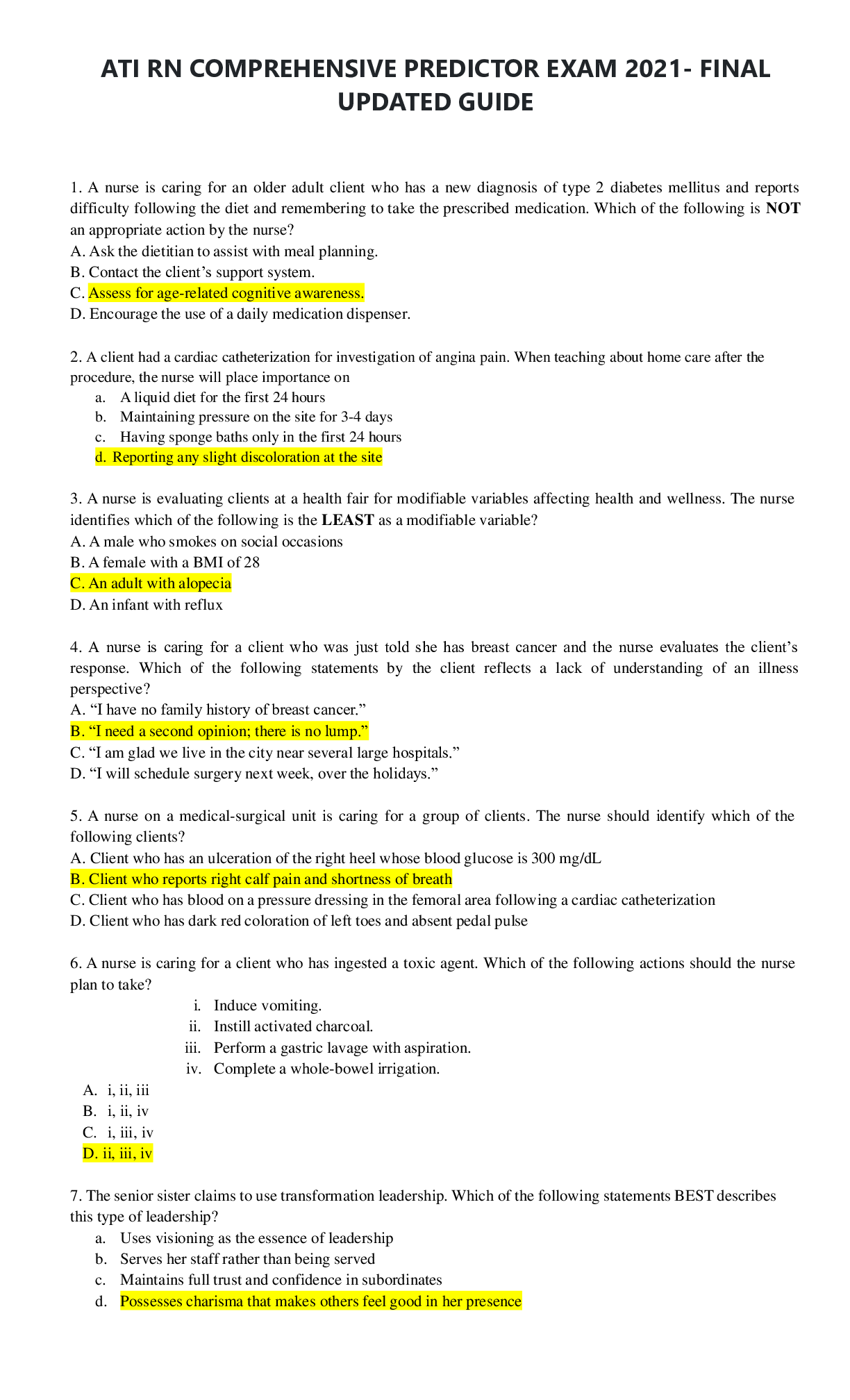
Reviews( 0 )
Document information
Connected school, study & course
About the document
Uploaded On
Nov 10, 2021
Number of pages
15
Written in
Additional information
This document has been written for:
Uploaded
Nov 10, 2021
Downloads
1
Views
275

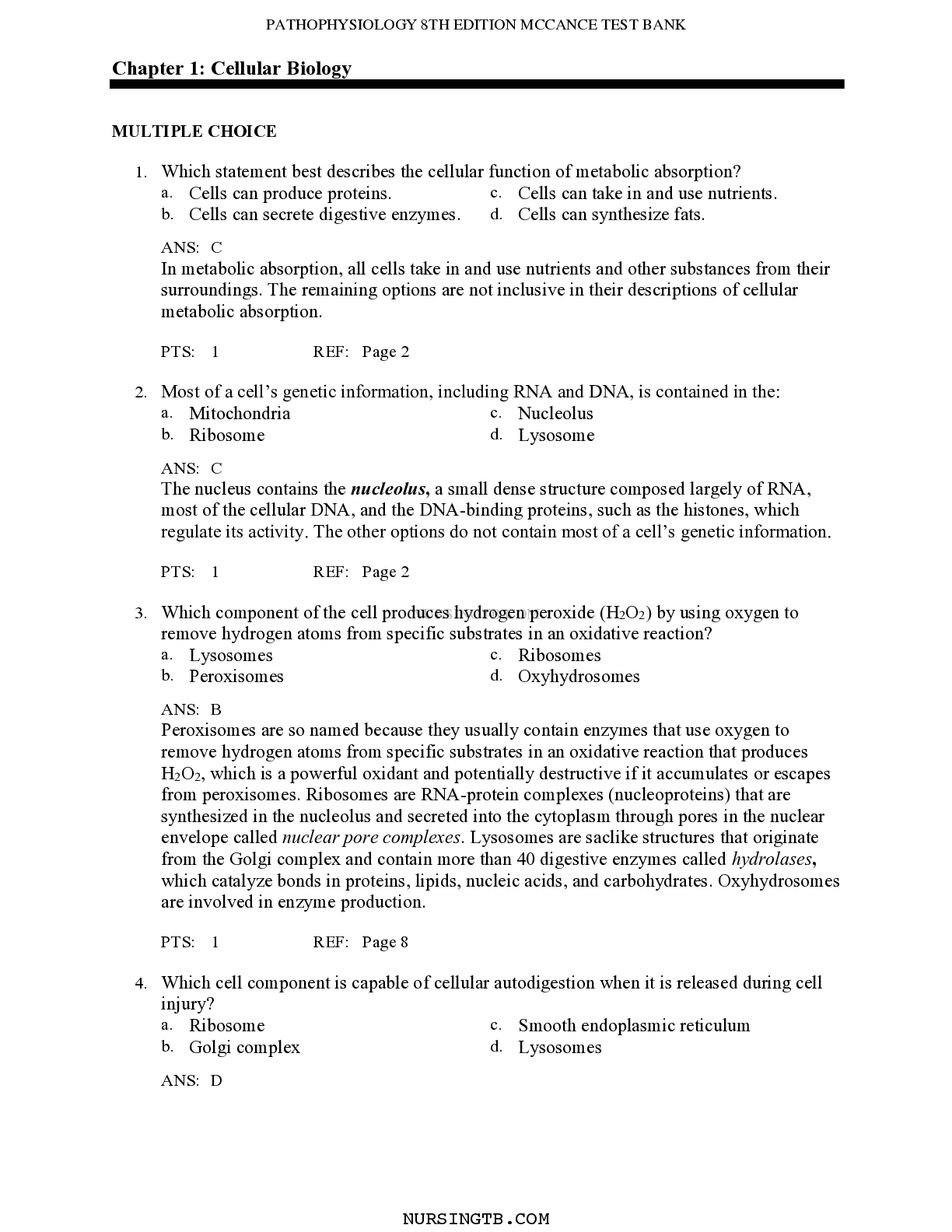

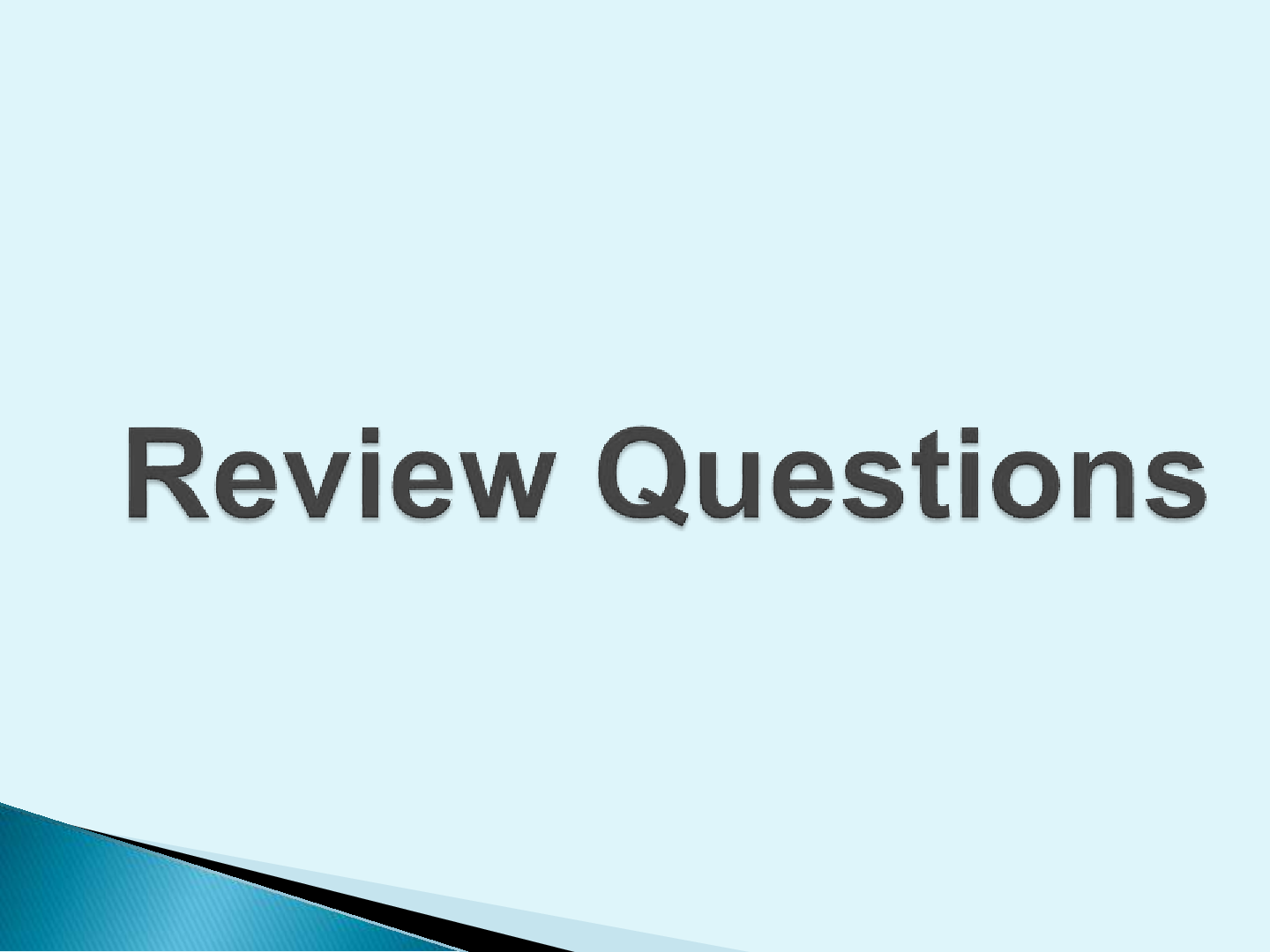
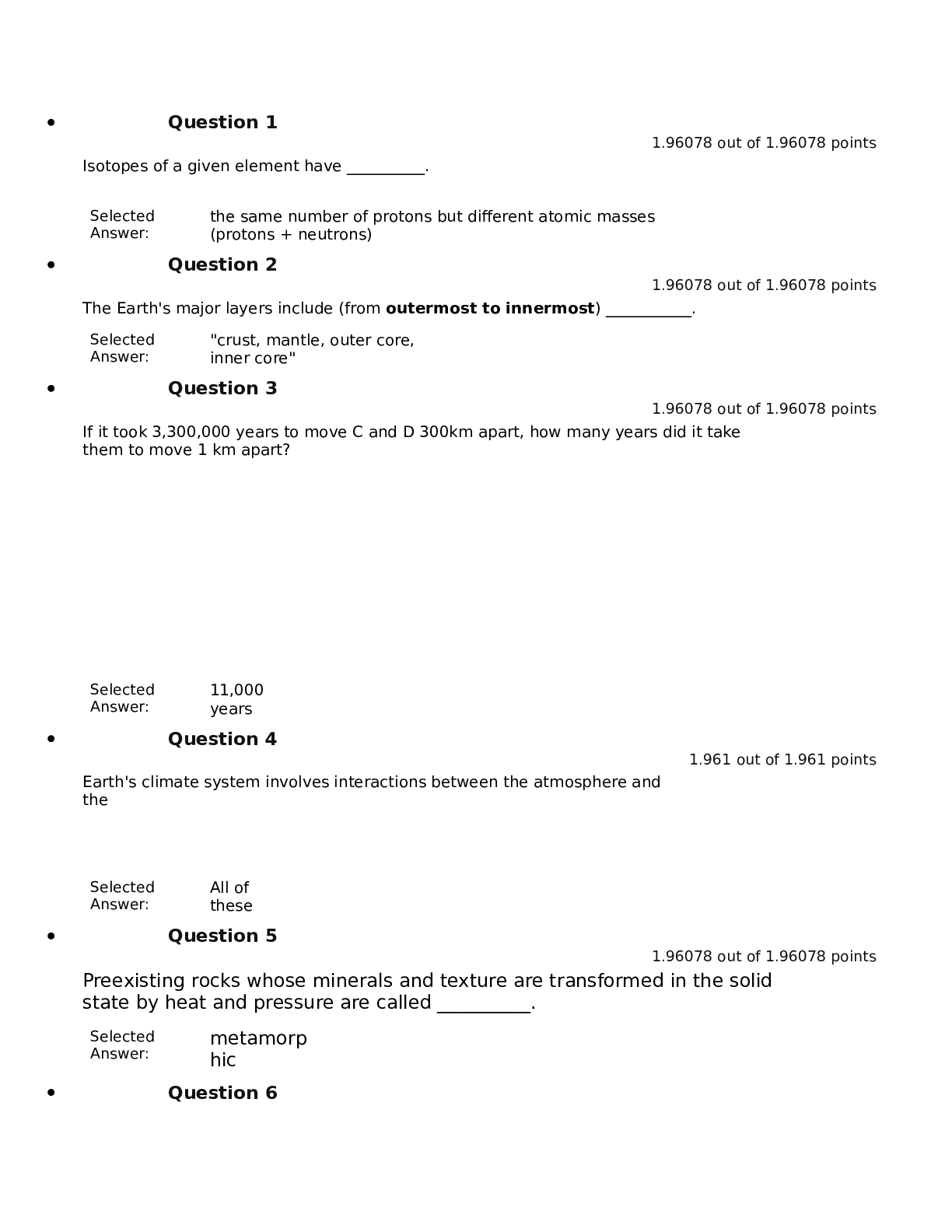
.png)
